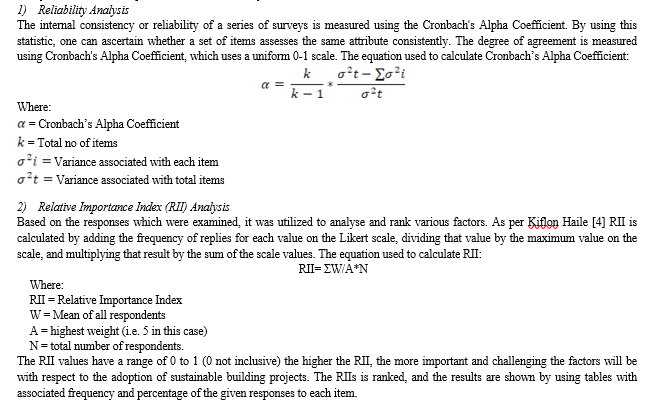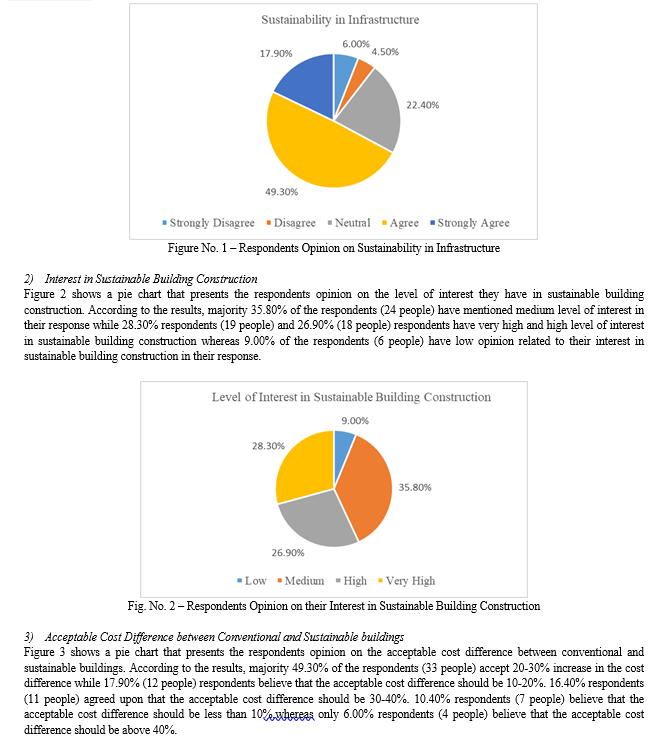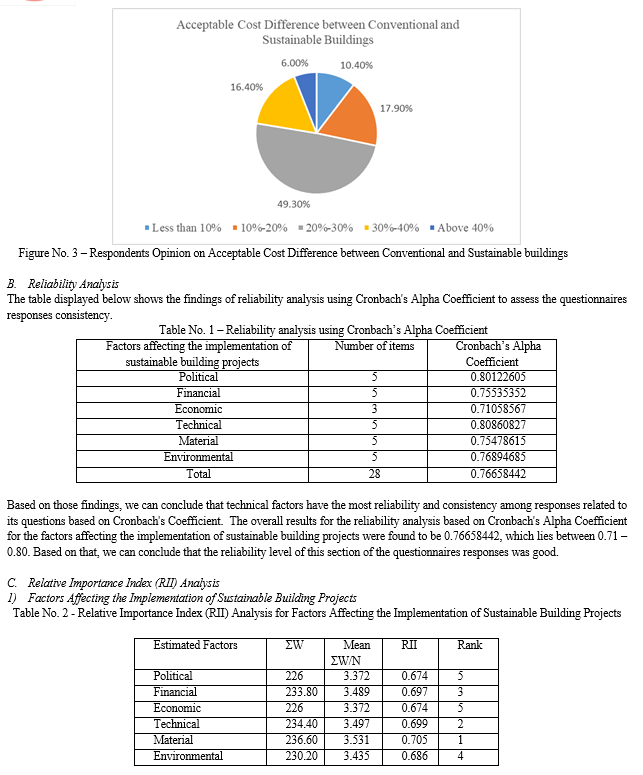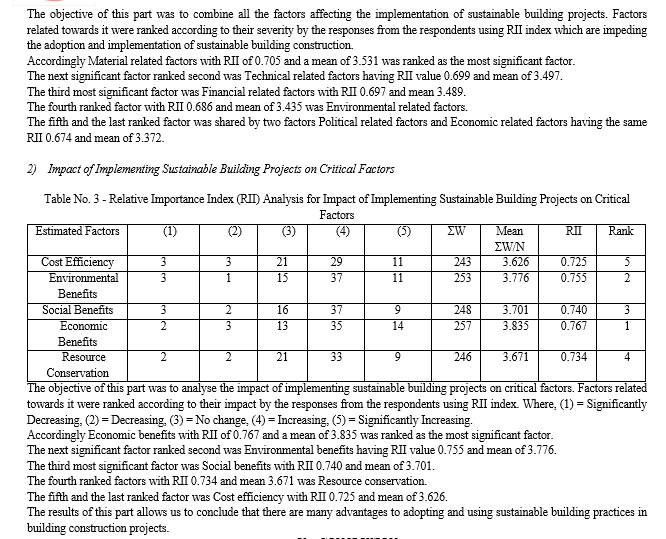Ijraset Journal For Research in Applied Science and Engineering Technology
- Home / Ijraset
- On This Page
- Abstract
- Introduction
- Conclusion
- References
- Copyright
Analysis of Factors Affecting the Implementation of Sustainable Building Projects
Authors: Vinay Warang, Prof. R. M. Swamy, Dr. Y. S. Patil
DOI Link: https://doi.org/10.22214/ijraset.2024.58786
Certificate: View Certificate
Abstract
Sustainability concept can be defined as “meeting the needs of the present without compromising the needs of the future” [7]. Conventional buildings approximately consumes more than 30% of energy while utilising around 40% of resources while also simultaneously generating 40% of wastes and 35% of harmful green-house gases [8]. The sustainable building construction approach has the potential to make a significant contribution to sustainable development, especially considering the building industry’s considerable influence. Based on our literature assessment, we discovered that multiple research reveal a general lack of consistency across outcomes in different geographical locations regarding factors impacting the implementation of sustainable building projects. Therefore this study is based on the analysis of factors that impact the implementation of sustainable building projects and the effects of sustainable building projects on various critical factors. For the result of the research analysis, the Reliability analysis which was conducted based on Cronbach\'s Alpha Coefficient for the factors affecting the implementation of sustainable building projects were found to be 0.76658442 which can conclude that the reliability level of the questionnaires responses was good while based on Relative Importance Index (RII) analysis factors affecting the implementation of sustainable building projects were ranked, with material related factors being the most significant (RII 0.705) among other factors. Additionally, the impact of implementing sustainable building projects on different critical factors was determined, with RII analysis indicating that the most significant impact will occur in terms of economic benefits (RII 0.767). Overall, the study tried fulfilling all the objectives which were stated.
Introduction
I. INTRODUCTION
In the Brudtland Report, released in 1987 by the United Nations World Commission on Environment and Development, the term "sustainability" was initially defined. Sustainability is defined as "meeting the needs of the present without compromising the needs of the future" as well as "ensuring a balance between economic growth, environmental protection and social well-being"[7]. Another meaning of sustainability is the use of natural resources in a way that preserves their equilibrium and prevents them from depleting and running out. The practice of selecting materials, their sources, construction techniques and design philosophies in a way that will maximize efficiency, lessen the project's environmental effect, decrease waste and be more ecologically friendly is known as sustainability in construction. Sustainability can be further divided into three main categories that is environmental, economic and social.
A. Sustainable Buildings
The arrival of the twenty-first century has brought with it the era of sustainable buildings. Conventional buildings use energy inefficiently, generate a lot of trash during construction and operations and release a lot of pollutants and greenhouse gases into the atmosphere. Sustainable building construction, as opposed to traditional construction, strives to maximize the use of resources such as land, energy and water, increase the use of recycled and renewable materials and enhance the quality of both indoor and outdoor air. According to Robert Cassidy [9] Sustainable buildings can be defined as structures that, over the course of its entire lifespan, has improved efficiency in its utilization of energy, water and materials while reducing its negative effects on human health and the environment through superior planning, design, construction, operation and maintenance.
According to UNEP Sustainable Buildings and Construction Initiative [12] the key attributes of the sustainable buildings are
- Taking sustainability into account at every stage of planning and building design.
- Taking sustainability into account when producing building materials and throughout construction.
- Making use of eco-friendly materials and products.
- Employing efficient systems.
- Making use of structures and systems that are simple to service and maintain.
- Preserving excellent functionality, adaptability and flexibility.
- Preserving the comfort and health of users, occupants and guests.
- Excellent aesthetic and urban design quality with strong public approval.
- Convenient location with easy access to networks and services for public transit.
B. Need for study
A vital component of every economy, the building sector still has a big effect on the environment. Because of its scale, the construction industry consumes a lot of energy, resources, water and other materials. It also pollutes heavily. Conventional buildings approximately consumes more than 30% of energy while utilising around 40% of resources while also simultaneously generating 40% of wastes and 35% of harmful green-house gases [8]. The sustainable building approach has a strong potential to make a significant contribution to sustainable development, given the construction industry's significant impact. At the moment, construction accounts for 10% of India's GDP as per data. According to a recent Mint article, India's construction sector is expected to grow into becoming the third largest in the next two to three years. Whereas India's sustainable buildings sector grew at a 7.5% annual rate between 2017 and 2022 as mentioned in report published on global data related to India’s market analysis. Construction of sustainable building projects will be essential to India's rise to the third-largest construction market. So the study done here was required to obtain information about analysis of factors that can have a significant impact on the implementation of sustainable building projects.
II. LITERATURE REVIEW
A. Comparative Study of Conventional and Green Residential Building, Amjad Nasser, Asmin Ashraf, Dilna K. Salim, Gayathri P., Vishnu N. (2017)
In comparison to a conventional building, a green building uses less energy, water and natural resources, produces less waste and is healthier for the occupants. The market for green building supplies is increasing quickly. By regulating solar radiation temperature, energy efficiency, water conservation using home treatment plants, and interior air quality, green buildings provide an appropriate atmosphere. The paper states that the green buildings primary goal was to reduce environmental effect from new construction. Reducing energy emissions and consumption by buildings is a good way to promote environmental sustainability. Utilizing energy effectively is sustainable. A green building is one that uses resources sparingly and with consideration for the environment during its entire life. The goal of this paper was to compare traditional and environmentally friendly dwelling construction. Energy 2D, a simulation tool for energy, displays temperature data in depth. There has to be research done on several green building rating systems. For the purpose of assessing the building using the LEED certification, the rate of water and electricity consumption, as well as trash generated in the chosen building, were collected. A model was created that included each component of a green building, including a cooling tunnel, biogas plant, grey water filter, rainwater gathering plant and biogas plant. The conclusion of the paper claims that, despite the initial high cost of implementing green buildings, it will ultimately prove to be cost-effective. Additionally, it ensures a sustainable means of living.
B. Sustainable Construction: Challenges and Opportunities, Daniel Baloi, (2003)
The construction industry is critical to a country’s economic and social development. The creation and responsible management of a healthy built environment based on resource efficient and ecological principles is what sustainable construction is all about. There is growing concern about the environmental impacts of construction activity and measures have been implemented to mitigate them. Legal frameworks, cultural, technological and managerial processes are examples of these measures. The construction industry is under intense pressure to adopt environmentally friendly practises and environmental stewardship is now viewed as a competitive advantage. This paper presents preliminary findings from a larger research project on sustainable construction implementation in Mozambique. The paper also presents and discusses the most significant challenges and opportunities confronting construction organisations in Mozambique when implementing environmental management systems. The information was gathered through a case study of a construction project conducted from the client’s point of view. The paper concludes by stating that construction companies must develop robust and innovative environmental management strategies in order to meet sustainability requirements and capitalise on opportunities created by the implementation of such practices.
C. Sustainable Construction Materials and Technology in Context with Sustainable Development, Kaanchan M. Patil, Mahendraa S. Patil, (2017)
The pursuit of sustainable development highlights the built environment and construction industry. Rapid urbanisation in India is causing massive environmental problems in the construction industry. Increased demand for residential dwelling units leads to increased consumption of energy, resources and raw materials all of which contribute to an increase in the carbon footprint. The purpose of this paper was to elaborate on the concept of sustainable development, which has gained prominence in the last twenty years. According to the paper, such development is possible through the use of sustainable construction materials and technology. Sustainable development expresses this concept through designs that exemplify conservation principles and encourage their application in our daily lives. The paper concludes by stating that more research is needed, and a new approach is needed to recognize the impacts of every material and technology selected on natural and cultural resources in local, regional and global environments.
D. Factors Affecting Sustainable Building Projects: The Case of Addis Ketema Sub City, Kiflom Haile (2022)
Every country’s progress depends on the building sector. In many aspects, the construction of physical infrastructure such as buildings, roads and bridges can be used to gauge a country’s economic growth rate. The research conducted in the paper was aimed to investigate variables influencing the growth of sustainable building projects in Addis Abeba, with a particular emphasis on the Addis Ketema Sub-city. Both a quantitative and a qualitative research approach were used in this study. The results of the research shows that a number of factors, including financial and economic ones, technological ones, material ones and environmental ones have an impact on the adoption and use of sustainable building in the studied area. The study’s results also confirmed that adopting sustainable building practices can have positive effects on the environment, society, safety and human adaptability in addition to being cost-effective.
E. Green Construction in India Gaining a Deeper Understanding, Mohammed Arif, Charles Egbu, Abid Haleem, John Ebohon, Malik M.A. Khalfan, (2009)
In recent years, India has experienced significant economic growth, which has resulted in an increase in construction activity. In India, annual construction investment is currently around $70 billion, with an identified need for an additional $50 billion and a 15% annual growth rate. Over the next ten years, it is estimated that supporting infrastructure will require an investment of approximately $163 billion. In July 2008, academics from the University of Salford in the United Kingdom and Jamia Millia Islamia University in India organised a workshop in New Delhi. This paper summarises the workshop’s findings and suggests future research directions in the field. The paper then discusses the workshop’s main objectives. The paper then provides an overview and analysis of the facilitated session in which certain questions about green issues in the Indian construction industry were asked and then discussed by the workshop participants. Finally, the paper summarises the outcomes of facilitated sessions from a workshop held in New Delhi, India. The findings highlighted major challenges, drivers, initiatives and methods of effective implementation and enforcement.
III. Methodology
In the methodology of the study, a questionnaire was developed to study and analyse about the factors affecting the implementation of sustainable building projects and the impact of sustainable building projects on various critical factors. The factors affecting were separated into six categories: political, financial, economic, technical as well as material and environmental factors. Furthermore, the questionnaire which was developed was influenced by Kiflom Hailee's journal [4], as well as from the literature review.
A. Design of Questionnaire Structure
A list of survey question was formulated based on literature review from various research papers. Majority questions in the questionnaire are multiple choice based questions. The questionnaire survey has various optional points that must be rated on a five-point scale. The scale for factors affecting sustainable building projects was described as follows: "5= Strongly Agree, 4= Agree, 3= Neutral, 2= Disagree, and 1= Strongly Disagree".
While the scale for impact of implementation of sustainable building projects on certain critical factors was described as follows: "5= Significantly Increasing, 4= Increasing, 3= No Change, 2= Decreasing, and 1= Significantly Decreasing".
- General Data Regarding the Respondents
The first section covers general data regarding the respondents. It also contains questions about opinion and interest of the respondents related to sustainable buildings. The first section contains following five questions:
a. What is your working experience?
b. What is your level of qualification?
c. Do you believe that the infrastructure sector needs to be more sustainable?
d . What level of interest do you have in sustainable building construction?
e. What is an acceptable initial cost difference between conventional buildings and sustainable buildings in your opinion?
2. Political Factors
The second section covers and examines the political factors affecting the implementation of sustainable building projects. The following political factors were listed in the second section:
a. Lack of promotional activities from the government regarding sustainable buildings.
b. Difficulties in obtaining extra clearances and approvals.
c. Government regulations pertaining to implementation of sustainable practices are not stringent or enforceable.
d. Limited number of policies and regulations related to sustainable building construction.
e. Limited number of incentives and tax break from government.
3. Financial Factors
The third section covers and examines the financial factors affecting the implementation of sustainable building projects. The following financial factors were listed in the third section:
a. Inadequate financial mechanisms and resources for sustainable building construction.
b. Budget constraints for sustainable adoption of construction technologies and materials.
c. Absence of financial incentives to encourage sustainable product financing and procurement.
d. Perception that sustainable buildings are more expensive than other options since it needs a larger initial investment.
e. Higher research cost and development cost for sustainable building products, systems and technologies.
4. Economic Factors
The fourth section covers and examines the economic factors affecting the implementation of sustainable building projects. The following economic factors were listed in the fourth section:
a. Insufficient and imprecise data on the financial effects of sustainable buildings.
b. Insufficient market demand and unpredictability in deploying new technologies.
c. Inadequate market regulations, price adjustments and standards to manage sustainable building materials.
5. Technical Factors
The fifth section covers and examines the technical factors affecting the implementation of sustainable building projects. The following technical factors were listed in the fifth section:
a. Insufficient technical expertise to employ sustainable construction methods.
b. Limited number of research facilities and educational initiatives.
c. Limited number of skilled workforce to implement, and manage new sustainable construction technologies.
d. Low level of interest from construction companies in improving technology.
e. Limited number of knowledgeable consultants and contractors being available with the necessary expertise on sustainable building construction.
6. Material Factors
The sixth section covers and examines the material factors affecting the implementation of sustainable building projects. The following material related factors were listed in the sixth section:
a. Difficulty in obtaining the required material resources.
b. Use of improper construction materials for respective function.
c. Lack of sustainable materials information.
d. Failure in using local, recyclable and renewable materials into account while choosing materials.
e. Misconception that the materials required will be super expensive.
7. Environmental Factors
The seventh section covers and examines the environmental factors affecting the implementation of sustainable building projects. The following environmental factors were listed in the seventh section:
a. Lack of any standard evaluation criteria for items that permits environmental evaluation.
b. Implementing substandard construction practices.
c. Destruction of all presently existing ecologically significant elements that surround the development site.
d. Negligence in promoting the use of sustainable energy sources.
e. Failure in employing checklists for environmental sustainability while monitoring construction activities.
8. Impact of Sustainable Building Projects on Critical Factors
The eight and the last section covers and examines the impact of implementing sustainable building projects on certain factors. The following factors were listed in the eight section:
a. Long term initial cost efficiency of building projects.
b. Long term environmental benefits.
c. Long term social benefits.
d. Long term economic benefits.
e. Long term resource conservation.
B. Methods of Data Analysis
The data which was collected from the questionnaire survey was then needed to be analyzed. For the analysis of data Reliability Analysis and Relative Importance Index (RII) Analysis method was used.

IV. RESULTS AND DISCUSSION
Participants completed the questionnaire that had 38 multiple-choice questions grouped into eight sections as part of the research methodology. All 67 respondents provided responses, all of which were carefully examined and analysed. The data in this study is intended to help achieve the study's analytical objective, which was to investigate the factors affecting the development of sustainable building projects and the impact of implementing such projects on critical factors. The following is an explanation of the study's data.
A. Demographic details
The demographic profile of the respondent is presented below. The reason for evaluating respondents work experience and educational background is that more educated and experienced respondents have a better chance of understanding the situation and providing responses that are more comprehensive.
Table No. 1 – Demographic Details of Respondents
|
Demographic Variables |
Items |
Frequency |
Percentage |
|
Working Experience |
0 – 5 years |
53 |
79.1 % |
|
5 – 10 years |
9 |
13.4 % |
|
|
11 – 15 years |
2 |
3 % |
|
|
Above 15 years |
3 |
4.5 % |
|
|
Total |
67 |
100 % |
|
|
Academic Status |
Student |
2 |
3 % |
|
Diploma |
8 |
11.2 % |
|
|
Under-Graduate |
34 |
50.7 % |
|
|
Post-Graduate |
23 |
34.3 % |
|
|
Total |
67 |
100 % |
Looking at the demographic profile of the respondents, the majority 79.1% of the respondents were having work experience in between 0-5 years while there were 13.4% of the respondents having 5-10 years of working experience. Whereas 3% and 4.5% of the respondents were having working experience between 11-15 years and above 15 years.
Regarding the educational background of the respondents, the majority 50.7% participants were Under-Graduates while there were 34.3% Post-Graduates followed by Diploma Holders which were 11.2% and Students which were 3% during the time of data collection. Hence most of the respondents were seen educated, assuming they are capable of conceptualizing and responding better on issues and practices of the case under study.
Based on the objectives of the study, the respondents were further asked their opinions related to sustainable buildings and the factors affecting the implementation of sustainable building construction projects in the study area. Then further the respondents were addressed to rate the different barriers found under each category using a five-point Likert scale. Finally, the top barriers were ranked using RII.
1) Sustainability in Infrastructure
Figure 1 shows a pie chart that presents the respondents opinion on if they believe that the infrastructure sector needs to be more sustainable. According to the results, majority 49.30% of the respondents (33 people) agreed in their response while 17.90% (12 people) respondents strongly agreed and believe that the infrastructure sector needs to be more sustainable while 22.40% (15 people) respondents remained neutral in their response whereas 4.50% (3 people) respondents disagreed and 6.00% (4 people) respondents strongly disagreed in their response.



Conclusion
Based on the result, the study examined and ranked various factors in the research area with material related factors being the most significant one with RII 0.705 which states that the materials used in building construction have a crucial role in the adoption of sustainable building practices. As a result, further research must be conducted regarding materials that have a lower impact on the environment and are more economical. Also the building materials should be made readily available locally. Whereas political along with economic related factors were the less significant factors with RII 0.674 among other factors which states that with regards to other factors it was low. Also for adoption of sustainable buildings the government should provide certain incentives, subsidies, tax relief and certain customized schemes for the research and development of sustainable building systems and technologies. Proper data analyses should be conducted and made readily available related to economic benefits of sustainable buildings in long term and also related to the market demand of sustainable building projects. Also the impact of sustainable building projects on various critical factor were identified where based on RII it was found out that the most significant impact of it will happen related to Economic benefit with RII 0.767. Based on that we can conclude that if sustainable building projects are properly implemented, they can result in significantly increasing economic benefits such as reduced building running costs, lower energy consumption and expenditures, increased economic efficiency as well as long term increased appreciation of the project compared to conventional projects.
References
[1] Amjad Nasser, Asmin Ashraf, Dilna K. Salim, Gayathri P., Vishnu N., (2017), Comparative Study of Conventional and Green Residential Building. International Journal of Innovative Science and Research Technology Volume 2, Issue 4 ISSN No: - 2456 – 2165. [2] Daniel Baloi, (2003), “Sustainable Construction: Challenges and Opportunities”, Greenwood, D J (Ed.), 19th Annual ARCOM Conference, University of Brighton, Association of Researchers in Construction Management, Vol. 1, pp. 289-97. [3] Kaanchan M. Patil, Mahendraa S. Patil, (2017), “Sustainable Construction Materials and Technology in Context with Sustainable Development”, International Journal of Engineering Research and Technology, ISSN 0974-3154 Volume 10, pp. 112-117. [4] Kiflom Haile, (2022), “Factors Affecting Sustainable Building Projects: The Case of Addis Ketema Sub City”, ISSN 2320-9186, GSJ: Volume 10, Issue 6, pp. 1900-1996 [5] Mohammed Arif, Charles Egbu, Abid Haleem, John Ebohon, Malik M.A. Khalfan, (2009), “Green Construction in India Gaining a Deeper Understanding”, Journal of Architectural Engineering ASCE. [6] Mohammad Sujayath Ali, Saliha Shukri, Mahaboob Patel, Abdul Ahad, (2020), “Alternative Building Materials for sustainable development in Ethiopian Construction”, International Research Journal of Engineering and Technology, ISSN: 2395-0056 Volume: 07 Issue: 06, pp. 2899-2903. [7] Mustafa Yilmaz, Adem Bakis, (2015), “Sustainability in construction sector”, Procedia – Social and Behavioural Sciences, pp. 2253-2262. [8] Prithviraj Dilip Mane, (2017), “Green Buildings and Sustainable Construction”, International Journal of Engineering Research & Technology, ISSN: 2278-0181 Vol. 6 Issue 12, pp. 362-376. [9] Robert Cassidy, (2003), “White paper on sustainability”, Building Design and Construction, pp. 1-48. [10] T.E. Uher and W. Lawson, “Sustainable development in construction”, Faculty of the Built Environment, UNSW, Sydney, Australia. [11] Tulay Civici, Resul Ozluk, (2020), “Potential barriers to sustainable construction: A model proposed”, Journal of Sustainable Construction Material and Technology, pp. 440–449. [12] Sustainable Buildings and Construction for India: Policies, Practices and Performance, UNEP Sustainable Buildings and Construction Initiative.
Copyright
Copyright © 2024 Vinay Warang, Prof. R. M. Swamy, Dr. Y. S. Patil. This is an open access article distributed under the Creative Commons Attribution License, which permits unrestricted use, distribution, and reproduction in any medium, provided the original work is properly cited.

Download Paper
Paper Id : IJRASET58786
Publish Date : 2024-03-05
ISSN : 2321-9653
Publisher Name : IJRASET
DOI Link : Click Here
 Submit Paper Online
Submit Paper Online

